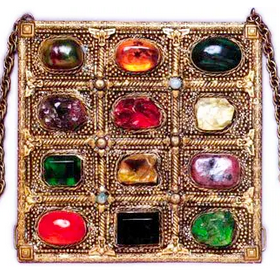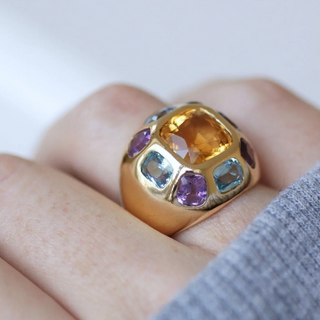Born in November, are you more inclined towards topaz or citrine? Like Gemini, who has been generously blessed with moonstone, alexandrite and pearl you have the luxury of choosing your birthstone. But yellow, please!
November birthstone

Aaron's breastplate necklace, pectoral decorated with fine stones representing the twelve tribes of Israel.
The different sources concerning the genesis of the birthstones all refer to the second book of the Bible, and more precisely to Aaron's breastplate decorated with fine stones representing the twelve tribes of Israel.
A first directory, associating each month of the year with a gemstone, seems to have been drawn up in Poland in the 18th century. Later, in 1912, the Americans proposed an official list of birthstones. This was updated in 1952 with the addition of alexandrite (discovered in the 1830s) and citrine. Meanwhile, in 1937, Great Britain's National Association of Goldsmiths decided to submit its own list. A Brexit on the scale of gemmology: those English certainly are!

Gold ball ring, citrine, blue topaz and amethyst
November's birthstone was yellow topaz until 1952, when citrine was added to the calendar. This is why both gems remain associated with Scorpio natives.

Spiral citrine ring on hammered gold
It would seem that citrine has long been referred to as yellow topaz. In addition, most of the misleading terminology for citrine includes the name topaz: Bahia topaz, Palmyra topaz for example. In reality, it is difficult to differentiate one gem from another, especially not on the basis of its color.
But let's focus on citrine.
The three ages of citrine

Milanese mesh cuff bracelet with diamonds and citrine
Citrine belongs to the quartz group. And you will discover that it is a big family! It is the third most common mineral on the surface of the Earth. The first one being ice (considering global warming, we don't know how long it will stay on the first place of the podium), while feldspar gets the silver medal. Does the term not ring a bell? Then let's talk about gems: amazonite, moonstone and labradorite belong for example to this mineral family. It's clearer, isn't it? We knew that you had made jewelry2nd language!
As for quartz, the bronze medal of the most common mineral on the surface of the Earth, in addition to citrine, which is the object of our attention, we can mention the following as belonging to the family agate, amethyst, chalcedony, carnelian, rock crystal or the (quartz) tiger's eye. We have put an ancient jewel behind each link, to help you recognize citrine's distant cousins at first glance!

Gustav Klimt, The Three Ages of Woman, 1905, Rome, Galleria Nazionale d'Arte Moderna e Comtemporanea.
The amethyst is more, one could even speak of the "three stages of the gem" to echo the painting of Gustav Klimt presented above. Indeed, amethysts have the property to transform into other stones.
Initially adorned with a purple hue, they become honey-colored when heated and then become citrines. Since citrines are rare in their natural state, they are often heated amethysts (or smoked quartz). The dominant color of natural citrines is pale yellow, but there are also dark yellow or caramel. In the latter case, they are called "Madeira" citrines.
And what about the third stage of amethyst? If you continue to heat the gem, it becomes a prasiolite, green in color.

Vintage amethyst cocktail ring
There are also hybrid gems composed of both amethyst and citrine called ametrines. The difference in coloring between the two parts of the same stone is explained by a heterogeneous stage of iron oxidation.
Where citrine comes from
Thus, you understand better why the deposits in which we find amethysts and citrines are identical! Among the main sources are: Brazil, Uruguay, Bolivia, Madagascar and historically Scotland.

Antique Scottish Surin brooch in silver, garnet, citrine, jasper and agate
Indeed, the "Cairngorm stone" is the name of a citrine specifically extracted from the mines of the eponymous Scottish mountains. Citrine is a popular ornament in Scottish jewelry. Democratized by the Queen VictoriaIt was one of the major trends of the 19th century, with the so-called "plaid" brooches. To learn more about the subject, we invite you to read our article available here.

Victorian style yellow and green gold cocktail ring with citrine
As for Queen Victoria, she is definitely our Godwin point: whether we are talking about the sapphireor the opal or the pink colorshe always slips into one chapter or another of our articles. Independently of our chronicle on her love story with Prince Albert (and their common passion for jewelry). Notice to lovers, the citrine celebrates thirteen years of marriage.
A stone as popular in France
Apart from the Scottish jewel, we find in France the gem in a more significant way in two specific periods of history: first in the nineteenth, at the time of the Restoration and the July Monarchy and in particular under the reign of Charles Xthen on the jewels of 1940s-50s. It is possible that the measured infatuation for citrine in time is related to the symbolism of the color yellow. But we don't say more for the moment: we are preparing an article on the subject.
In any case, these two periods have nothing to do with each other in terms of jewelry: on the one hand, we can observe delicate ornaments highlighting the work of gold with techniques such as grenetis, canetille or stamping (we refer you to the History of jewelry in the 19th century [part 1for definitions).

Yellow gold antique coin pendant

Tank citrine and diamonds ring on pink gold
On the other hand, tank jewelry can be recognized by its imposing volume and architectural lines, as well as by the combined influence of mechanization and Hollywood glamour.
Incidentally, there is a theory on the subject: it is thought possible that fine stone, relatively abundant and less expensive than precious stones, was favored at these periods of history in part to counteract the difficulty of access to raw materials. It would also have allowed the creation of voluminous jewelry at lower cost for the aristocrats and bourgeois impoverished by the French revolution and the following century, the Second World War. An ornament preserving the appearances in short.
The symbolism of citrine
Moreover, the color yellow is symbolically associated with the sun and the joy of living: a ray of light in these dark periods of French history. And since citrine is reputed to promote prosperity and abundance, it didn't hurt to wear it.

The gem will know thereafter a return of flame in the 1970s. It is notably found adorning cocktail rings, like our model above.
Finally, the name of the stone comes from the Latin citrus meaning "lemon". Do you know this expression: "When life gives you le mons , make lemonade "? It's a saying that encourages optimism and perseverance.
At Galerie Pénélope, when we are given lemons... well, we make lemons!
Find our antique jewelry gemstones, as well as a selection of quartz, in the drop-down menu on the right or below for the mobile version.
No jealousy if you are not born in November, discover your here your birthstone.
bracelet-manchette-maille-milanaise-gold-citrine-diamond: ring-spiral-citrine-gold-martele: bracelet-manchette-charles-x-gold-citrine: ring-boule-vintage-gold-yellow-citrine-amethyst-topaz: ring-cocktail-citrine-gold: ring-annees-70-jonc-pyramidale-gold-citrine
